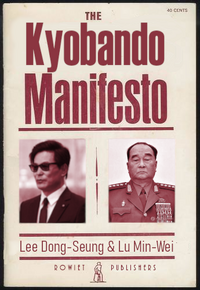
UCCR-Era Edition of the Manifesto; incorrectly attributing it solely to the work of two men.
The Kyobando Manifesto of 3597 was the document which described the Kyo ethnic nationalist idea of "Kyobando" (쿄반도). The ideology called for the reclamation of the Kyo homeland on the Dranian Peninsula and emphasized the importance of enforcing native culture in Dranland. This manifesto was a guiding force for the revolutionary fighters of the Great Kyo Revolution of 3608 and it continued to have a significant influence on politicians in Dankuk for over a century.
Originally published online by the Revolutionary Committee of the Kyo Defense Force (later becoming the Kyo Revolutionary Society, it is not known who authored the manifesto. It is believed that the document had multiple contributors, all united by their ultra-nationalist cause.
Today, many regard the Kyobando Manifesto as an important founding document for Dankuk, and it and the Kyo nationalist movement in general are widely celebrated in the modern Kyo State. The manifesto is a required reading for all high schoolers in the KCCR; though this practice has not been carried over to it's sister republics. Nonetheless; the modern conception has been shifted from a blatant piece of ethno-nationalist propaganda to a document advocating for the national right to self-determination as championed by the current Kyo government. Most elements of total Kyo domination have been removed or sanitized in modern education and dissemination of the manifesto; instead being replaced with the idea of the Kyo becoming a "paramount people" that remains the first among equals.
